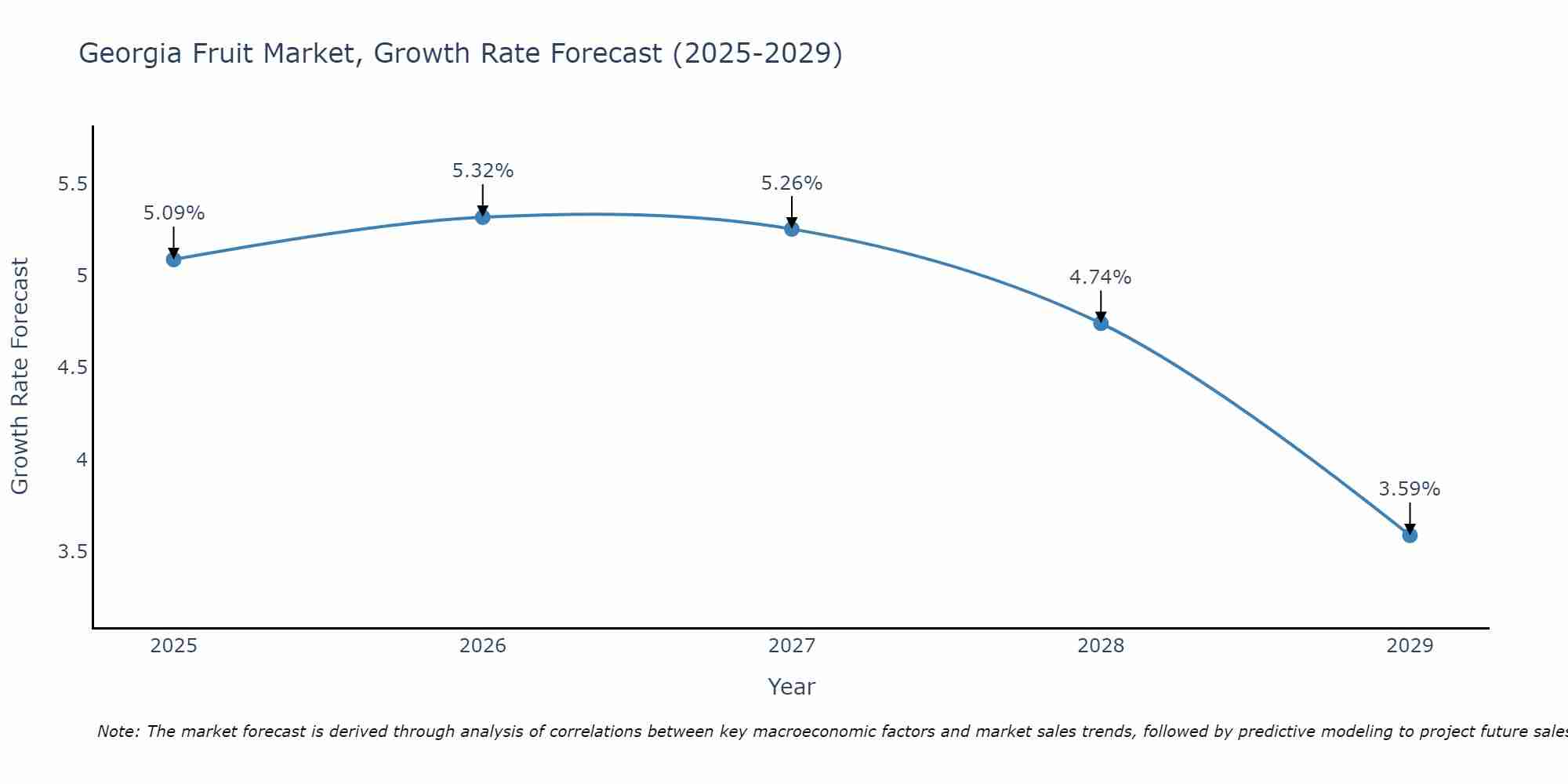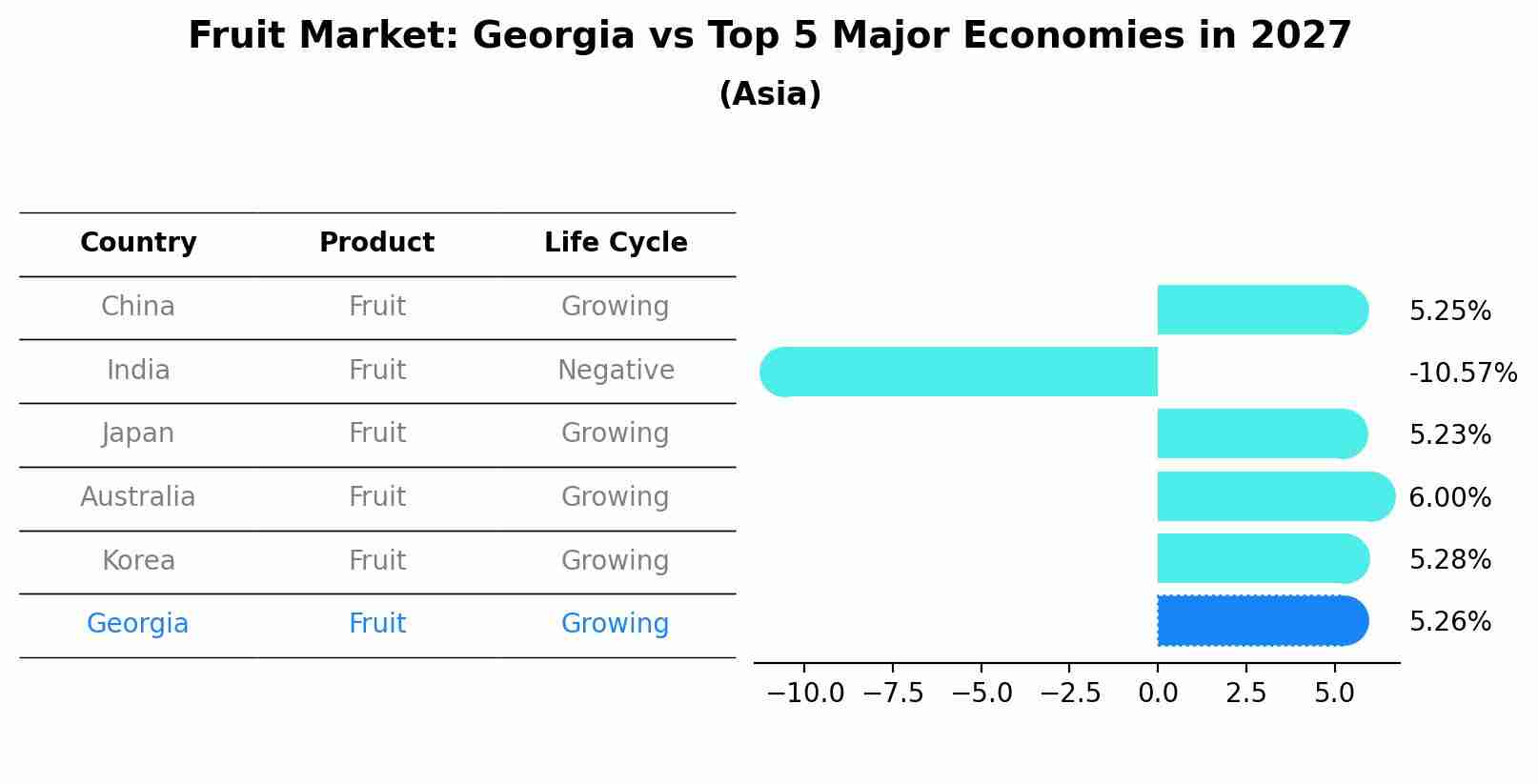Georgia Fruit Market (2025-2031) | Growth, Share, Size, Forecast, Companies, Trends, Value, Industry, Revenue, Analysis & Outlook
| Product Code: ETC020060 | Publication Date: Oct 2020 | Updated Date: Jun 2025 | Product Type: Report | |
| Publisher: 6Wresearch | Author: Vasudha | No. of Pages: 70 | No. of Figures: 35 | No. of Tables: 5 |
Georgia Fruit Market Size Growth Rate
The Georgia Fruit Market is projected to witness mixed growth rate patterns during 2025 to 2029. Growth accelerates to 5.32% in 2026, following an initial rate of 5.09%, before easing to 3.59% at the end of the period.

Fruit Market: Georgia vs Top 5 Major Economies in 2027 (Asia)
Georgia's Fruit market is anticipated to experience a growing growth rate of 5.26% by 2027, reflecting trends observed in the largest economy China, followed by India, Japan, Australia and South Korea.

Georgia Fruit Market Overview
The Georgia Fruit Market is a bustling and vibrant marketplace located in downtown Atlanta, Georgia. This market offers a wide variety of fresh fruits sourced from local farmers and distributors, providing customers with high-quality produce at affordable prices. Visitors to the market can expect to find an array of fruits including peaches, strawberries, blueberries, and watermelons, all of which are known for their freshness and delicious flavor. The market is a popular destination for both locals and tourists looking to experience the bounty of Georgia`s agricultural offerings. With its lively atmosphere and diverse selection of fruits, the Georgia Fruit Market is a must-visit for anyone seeking a taste of the region`s best produce.
Georgia Fruit Market Trends
The Georgia fruit market is currently experiencing a growing demand for locally sourced and organic fruits. Consumers are increasingly seeking out fresh, high-quality produce that is grown sustainably and supports local farmers. There is also a trend towards unique and exotic fruit varieties, as consumers are becoming more adventurous in their culinary choices. Additionally, there is a rising awareness of the health benefits of fruits, leading to an increased interest in superfoods like blueberries, peaches, and watermelon, which are known for their nutritional value. The market is also seeing a shift towards convenience, with pre-cut and packaged fruit options becoming more popular among busy consumers looking for quick and healthy snack choices. Overall, the Georgia fruit market is evolving to meet the changing preferences and lifestyles of consumers.
Georgia Fruit Market Challenges
In the Georgia fruit market, several challenges are faced by growers and sellers. One significant challenge is the impact of weather conditions on fruit production. Unpredictable weather patterns, such as frost, hail, or drought, can damage crops and reduce yields, leading to financial losses for farmers. Another challenge is the competition from imported fruits, which can often be cheaper due to lower production costs in other countries. This can make it difficult for local growers to compete in terms of pricing. Additionally, issues related to pests and diseases can also affect fruit quality and quantity, requiring farmers to invest in pest management solutions. Overall, the Georgia fruit market faces challenges related to weather, competition from imports, and pest control that can impact the profitability and sustainability of fruit production in the region.
Georgia Fruit Market Investment Opportunities
The Georgia Fruit Market offers various investment opportunities for individuals looking to capitalize on the thriving agricultural sector. Investors can consider investing in fruit farms to benefit from the state`s conducive climate for fruit cultivation, particularly peaches, blueberries, and apples. Additionally, there is potential in investing in processing facilities for fruit products such as juices, jams, and preserves to cater to the growing demand for value-added fruit products. Another opportunity lies in distribution and exportation channels to tap into regional and international markets. Moreover, investing in research and technology to enhance crop yield and quality can also be a promising avenue for growth in the Georgia Fruit Market. Overall, the market presents a range of investment prospects for those interested in the agricultural industry.
Georgia Fruit Market Government Policy
The government of Georgia has implemented various policies to support the fruit market within the state. These policies include providing financial incentives to fruit farmers, offering subsidies for the purchase of farming equipment and technology, and promoting sustainable agricultural practices. Additionally, the government has set standards and regulations to ensure the quality and safety of fruits produced in Georgia, as well as to facilitate trade both domestically and internationally. Through these policies, the government aims to boost the growth of the fruit market, increase productivity, and enhance the competitiveness of Georgia`s fruit industry in the global market.
Georgia Fruit Market Future Outlook
The future outlook for the Georgia Fruit Market appears promising due to several key factors. Consumer demand for fresh and locally sourced produce continues to rise, driving increased interest in farmers markets and direct-to-consumer sales. Georgia`s favorable climate and diverse agricultural landscape position the state as a prime location for fruit production, allowing for a wide variety of fruits to be cultivated year-round. Additionally, advancements in technology and logistics are enabling greater efficiency in the supply chain, reducing waste and ensuring fresher products reach consumers. With a growing emphasis on health and sustainability, the Georgia Fruit Market is well-positioned to capitalize on these trends and establish itself as a key player in the regional and national fruit market.
Key Highlights of the Report:
- Georgia Fruit Market Outlook
- Market Size of Georgia Fruit Market, 2024
- Forecast of Georgia Fruit Market, 2026
- Historical Data and Forecast of Georgia Fruit Revenues & Volume for the Period 2021 - 2031
- Georgia Fruit Market Trend Evolution
- Georgia Fruit Market Drivers and Challenges
- Georgia Fruit Price Trends
- Georgia Fruit Porter's Five Forces
- Georgia Fruit Industry Life Cycle
- Historical Data and Forecast of Georgia Fruit Market Revenues & Volume By Applications for the Period 2021 - 2031
- Historical Data and Forecast of Georgia Fruit Market Revenues & Volume By Supermarkets and Hypermarkets for the Period 2021 - 2031
- Historical Data and Forecast of Georgia Fruit Market Revenues & Volume By Specialty Stores for the Period 2021 - 2031
- Historical Data and Forecast of Georgia Fruit Market Revenues & Volume By Online for the Period 2021 - 2031
- Historical Data and Forecast of Georgia Fruit Market Revenues & Volume By Type for the Period 2021 - 2031
- Historical Data and Forecast of Georgia Fruit Market Revenues & Volume By Fresh for the Period 2021 - 2031
- Historical Data and Forecast of Georgia Fruit Market Revenues & Volume By Dried for the Period 2021 - 2031
- Historical Data and Forecast of Georgia Fruit Market Revenues & Volume By Frozen for the Period 2021 - 2031
- Historical Data and Forecast of Georgia Fruit Market Revenues & Volume By Others for the Period 2021 - 2031
- Georgia Fruit Import Export Trade Statistics
- Market Opportunity Assessment By Applications
- Market Opportunity Assessment By Type
- Georgia Fruit Top Companies Market Share
- Georgia Fruit Competitive Benchmarking By Technical and Operational Parameters
- Georgia Fruit Company Profiles
- Georgia Fruit Key Strategic Recommendations
Frequently Asked Questions About the Market Study (FAQs):
1 Executive Summary |
2 Introduction |
2.1 Key Highlights of the Report |
2.2 Report Description |
2.3 Market Scope & Segmentation |
2.4 Research Methodology |
2.5 Assumptions |
3 Georgia Fruit Market Overview |
3.1 Georgia Country Macro Economic Indicators |
3.2 Georgia Fruit Market Revenues & Volume, 2019 & 2026F |
3.3 Georgia Fruit Market - Industry Life Cycle |
3.4 Georgia Fruit Market - Porter's Five Forces |
3.5 Georgia Fruit Market Revenues & Volume Share, By Applications, 2019 & 2026F |
3.6 Georgia Fruit Market Revenues & Volume Share, By Type, 2021 & 2031F |
4 Georgia Fruit Market Dynamics |
4.1 Impact Analysis |
4.2 Market Drivers |
4.3 Market Restraints |
5 Georgia Fruit Market Trends |
6 Georgia Fruit Market, By Types |
6.1 Georgia Fruit Market, By Applications |
6.1.1 Overview and Analysis |
6.1.2 Georgia Fruit Market Revenues & Volume, By Applications, 2016 - 2026F |
6.1.3 Georgia Fruit Market Revenues & Volume, By Supermarkets and Hypermarkets, 2016 - 2026F |
6.1.4 Georgia Fruit Market Revenues & Volume, By Specialty Stores, 2016 - 2026F |
6.1.5 Georgia Fruit Market Revenues & Volume, By Online, 2016 - 2026F |
6.2 Georgia Fruit Market, By Type |
6.2.1 Overview and Analysis |
6.2.2 Georgia Fruit Market Revenues & Volume, By Fresh, 2016 - 2026F |
6.2.3 Georgia Fruit Market Revenues & Volume, By Dried, 2016 - 2026F |
6.2.4 Georgia Fruit Market Revenues & Volume, By Frozen, 2016 - 2026F |
6.2.5 Georgia Fruit Market Revenues & Volume, By Others, 2016 - 2026F |
7 Georgia Fruit Market Import-Export Trade Statistics |
7.1 Georgia Fruit Market Export to Major Countries |
7.2 Georgia Fruit Market Imports from Major Countries |
8 Georgia Fruit Market Key Performance Indicators |
9 Georgia Fruit Market - Opportunity Assessment |
9.1 Georgia Fruit Market Opportunity Assessment, By Applications, 2019 & 2026F |
9.2 Georgia Fruit Market Opportunity Assessment, By Type, 2019 & 2026F |
10 Georgia Fruit Market - Competitive Landscape |
10.1 Georgia Fruit Market Revenue Share, By Companies, 2024 |
10.2 Georgia Fruit Market Competitive Benchmarking, By Operating and Technical Parameters |
11 Company Profiles |
12 Recommendations |
13 Disclaimer |
- Single User License$ 1,995
- Department License$ 2,400
- Site License$ 3,120
- Global License$ 3,795
Search
Thought Leadership and Analyst Meet
Our Clients
Related Reports
- Canada Oil and Gas Market (2026-2032) | Share, Segmentation, Value, Industry, Trends, Forecast, Analysis, Size & Revenue, Growth, Competitive Landscape, Outlook, Companies
- Germany Breakfast Food Market (2026-2032) | Industry, Share, Growth, Size, Companies, Value, Analysis, Revenue, Trends, Forecast & Outlook
- Australia Briquette Market (2025-2031) | Growth, Size, Revenue, Forecast, Analysis, Trends, Value, Share, Industry & Companies
- Vietnam System Integrator Market (2025-2031) | Size, Companies, Analysis, Industry, Value, Forecast, Growth, Trends, Revenue & Share
- ASEAN and Thailand Brain Health Supplements Market (2025-2031) | Strategy, Consumer Insights, Analysis, Investment Trends, Opportunities, Growth, Size, Share, Industry, Revenue, Segments, Value, Segmentation, Supply, Forecast, Restraints, Outlook, Competition, Drivers, Trends, Demand, Pricing Analysis, Competitive, Strategic Insights, Companies, Challenges
- ASEAN Bearings Market (2025-2031) | Strategy, Consumer Insights, Analysis, Investment Trends, Opportunities, Growth, Size, Share, Industry, Revenue, Segments, Value, Segmentation, Supply, Forecast, Restraints, Outlook, Competition, Drivers, Trends, Demand, Pricing Analysis, Competitive, Strategic Insights, Companies, Challenges
- Europe Flooring Market (2025-2031) | Outlook, Share, Industry, Trends, Forecast, Companies, Revenue, Size, Analysis, Growth & Value
- Saudi Arabia Manlift Market (2025-2031) | Outlook, Size, Growth, Trends, Companies, Industry, Revenue, Value, Share, Forecast & Analysis
- Uganda Excavator, Crane, and Wheel Loaders Market (2025-2031) | Strategy, Consumer Insights, Analysis, Investment Trends, Opportunities, Growth, Size, Share, Industry, Revenue, Segments, Value, Segmentation, Supply, Forecast, Restraints, Outlook, Competition, Drivers, Trends, Demand, Pricing Analysis, Competitive, Strategic Insights, Companies, Challenges
- Rwanda Excavator, Crane, and Wheel Loaders Market (2025-2031) | Strategy, Consumer Insights, Analysis, Investment Trends, Opportunities, Growth, Size, Share, Industry, Revenue, Segments, Value, Segmentation, Supply, Forecast, Restraints, Outlook, Competition, Drivers, Trends, Demand, Pricing Analysis, Competitive, Strategic Insights, Companies, Challenges
Industry Events and Analyst Meet
Whitepaper
- Middle East & Africa Commercial Security Market Click here to view more.
- Middle East & Africa Fire Safety Systems & Equipment Market Click here to view more.
- GCC Drone Market Click here to view more.
- Middle East Lighting Fixture Market Click here to view more.
- GCC Physical & Perimeter Security Market Click here to view more.
6WResearch In News
- Doha a strategic location for EV manufacturing hub: IPA Qatar
- Demand for luxury TVs surging in the GCC, says Samsung
- Empowering Growth: The Thriving Journey of Bangladesh’s Cable Industry
- Demand for luxury TVs surging in the GCC, says Samsung
- Video call with a traditional healer? Once unthinkable, it’s now common in South Africa
- Intelligent Buildings To Smooth GCC’s Path To Net Zero


















